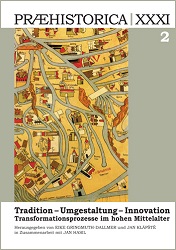Hochmittelalterliche Transformationsprozesse und ihre Wirkung auf das Siedlungsbild Ostösterreichs
High Medieval Transformation Processes and their Impact on Settlement Patterns in Eastern Austria
Author(s): Heike Krause, Thomas KühtreiberSubject(s): Architecture, Social history, Social development, Rural and urban sociology, 13th to 14th Centuries, 15th Century
Published by: Univerzita Karlova v Praze, Nakladatelství Karolinum
Keywords: Austria (Styria-Lower Austria-Upper Austria); town; central place; castle/manor house; rural settlement; deserted village; High Middle Ages;
Summary/Abstract: The article examines transformation processes in the eastern part of modern-day Austria, to be exact in Upper Austria, Lower Austria and Styria. In the Early Middle Ages most of this region was shaped by the former Roman provinces and their settlement structures. This pattern of settlement was transformed from the migration period to the 8th/9th centuries by the decline and/or abandonment of the former Roman central places. After the end of the Avar Khaganate and the incorporation of the area into the Carolingian Empire, some of the Roman fortifications, particularly along the Danube, were re-used as administrative centres and markets. The defeat of the Bavarian army by the Hungarians at Bratislava/Pressburg in 907 led to the loss of the region east of the river Enns until the second half of the 10th century, but archaeological evidence indicates more or less continuous settlement and even trade between the Ottonian Empire and the population in the Hungarian area of influence. While the land east of the Enns was reincorporated into the empire after the “Battle in the Lechfeld” in 955, reaching the rivers March, Fischa and lastly the Leitha in the first half of the 11th century, there is little archaeological evidence for the increasing political stability of the eastern marches of the Holy Roman Empire. The political changes in the Babenberg county caused by the Investiture Conflict in the late 11th century not only involved a concentration of power in the hands of the Babenberg counts, but also led to a rise in the importance of some noble vassal families. These families displaced some of the higher ranked Bavarian noble families, which had been involved in the colonisation of these regions until the Investiture Conflict, and thereafter formed the nucleus of late landlord society in the Austrian duchy from the 13th century onwards. Framed by this political context, we can observe fundamental changes in the pattern of settlement in Eastern Austria between the 12th and 14th centuries. Based on the consolidation of the political and economic situation and on a rising population density, the landscape was transformed by centralisation and fusion processes: Rural settlements were abandoned in favour of new towns or growing older centres and market sites with a population differentiated by profession. The high density of castles as a mirror of complex political patterns based on dominion rooted in personal relations in the 11th and 12th centuries changed from the 13th century onwards to a lesser number of castles as centres of territorial lordship. Many smaller castles were replaced by less-fortified manorial buildings as subordinate elements of a territorial lordship. The more or less parallel shift from a mixed ecclesiastical structure in the region, based both on aristocratic demesne churches and on churches as pastoral centers of catholic institutions, towards a regular parochial network in the Late Middle Ages is not easy to prove by archaeological means. However, the rising importance of the Mendicant orders as part of the religious organisation of the flourishing towns does find its expression in the architectural and archaeological record. These multifaceted trends continue until the 15th/16th centuries and many phenomena associated with the early modern territorial state have their roots in the transformation processes of the 12th–14th centuries.
Journal: Praehistorica
- Issue Year: 31/2013
- Issue No: 2
- Page Range: 221-268
- Page Count: 48
- Language: German

